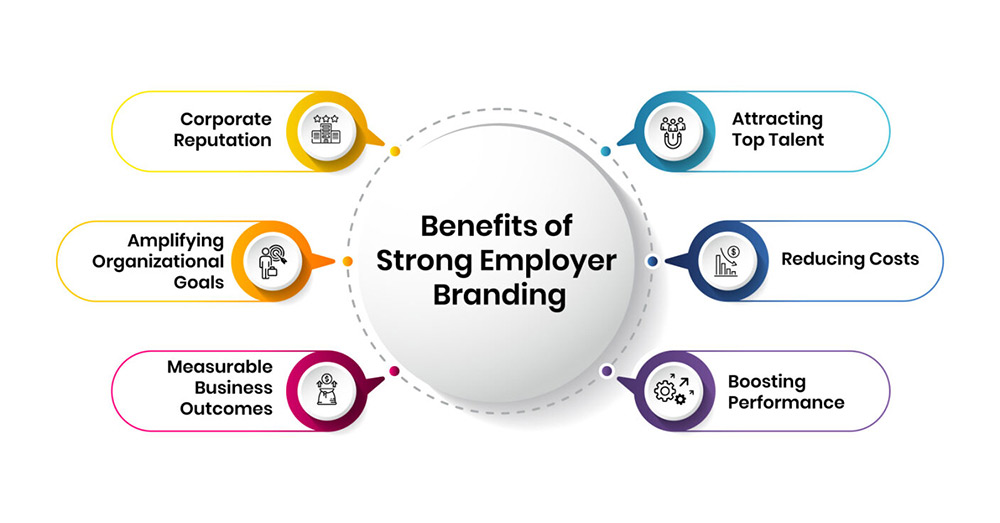How Struggling Companies Can Use Employer Branding to Overcome Business Challenges
August 18, 2024

Employer branding is a critical but often overlooked aspect of human resource management, especially for companies facing headwinds. A strong employer brand helps struggling firms stay attractive and competitive in recruiting even when their financial performance may be turbulent. It reassures job seekers about long-term prospects and builds trust during uncertainty. Though the constraints of a difficult market environment pose unique challenges, with careful planning struggling organizations too can develop impactful employer branding strategies.
This article explores how strategic employer branding can help firms facing business struggles to acquire and engage talent. It outlines specific techniques relevant to the context and makes a case for it to be viewed as a business priority rather than just an HR exercise. With focused efforts to differentiate their employment proposition, companies can turn adversity into an opportunity to lay the foundations for future growth.
Understanding Employer Branding
Employer branding refers to the reputation of a company as a place to work. It involves cultivating a desirable image for prospective employees and managing the current employee experience. A strong employer brand helps companies attract and retain top talent.
Several factors shape an employer's brand. The personality of the brand is portrayed by imagining the company as a person. The voice and tone used in communications must align with the target candidates. The employer's mission should appeal to employees beyond the company's overall goals.
Core brand values should attract candidates who share similar ideals. For example, a value like creativity would require nurturing creative work. The brand experience encompasses recruitment processes and employee satisfaction over time based on addressing worker needs.
Whether companies participate actively or passively, current and former staff will discuss their workplace with others. An employer's brand reputation develops from these discussions. Organizations can choose to steer this conversation by managing their brand or leave it to chance.
A strategic employer branding approach requires a commitment beyond initial planning. Adaptation to industry changes and remote work trends remains crucial. Focusing on clear internal and external communication nurtures a compelling reputation appealing to today's competitive landscape. Such brand differentiation positions companies as top career destinations.
The Benefits of Strong Employer Branding
A strong employer brand offers numerous advantages, including attracting top talent and enhancing employee retention. The following benefits show how effective employer branding contributes to organizational success:

-
Attracting Top Talent
With a strong employer brand, companies can attract highly skilled candidates in a competitive job market. By showcasing unique aspects like company culture, career development opportunities, and employee success stories, organizations can differentiate themselves and highlight the benefits of working there. Targeted advertising and social media campaigns can help reach desired audiences.
-
Reducing Costs
Employer branding has been shown to improve key business metrics. It can reduce cost-per-hire by needing fewer resources to find talent. Strong brands also experience less employee turnover, saving retention costs. Overall branding ROI can be measured through metrics like these.
-
Boosting Performance
Employees are more engaged when they feel pride in their employer's reputation. Positive employer branding leads to improved performance across organizations, impacting recruiting, retention, engagement, and profitability. Staff work better when they recommend the company and feel its values align with their own.
-
Corporate reputation
A positive employer brand enhances the overall corporate reputation of a company. When job seekers and current employees feel good about working at a company, it boosts the company's image publicly. A strong reputation makes a company appear more competitive and successful.
-
Amplifying Organizational Goals
Well-articulated employer branding ensures employees and potential hires understand and align with the company's culture, objectives and strategies. It fosters greater commitment to achieving shared organizational goals which supports business growth.
-
Measurable Business Outcomes
Positive employer branding impacts concrete business metrics such as reduced cost-per-hire, decreased attrition rates, and increased revenue and profits which are traceable to improved talent acquisition and retention. It ultimately enhances competitiveness and long-term growth.
Maintaining this reputational advantage requires a strategic, ongoing approach involving the whole team. Accounting for changing needs, continuously developing content, reviewing processes, and tracking results helps companies strengthen their employer brands over time.
Common Challenges Faced by Struggling Companies
Struggling companies often face financial difficulties such as declining revenues, shrinking profit margins, cash flow problems and mounting debts. They may be struggling to compete effectively in their industry due to factors such as declining market share, outdated business models and an inability to adapt to changing customer needs and market trends.
Additionally, struggling companies commonly experience poor employee morale as a result of issues like low job satisfaction, lack of direction and vision from leadership, and uncertainty about the future of the business.
Impact of These Challenges
These challenges can significantly impact a business's overall performance and ability to grow. Financial difficulties can constrain a company's ability to invest in critical areas like research and development, marketing, expanding into new markets, and upgrading technology. This hinders their ability to stay competitive and opens new opportunities for growth.
Declining market share means shrinking revenues as more customers are lost to competitors. Cash flow problems may result in the inability to pay debts on time or maintain regular operations.
Poor employee morale can lead to low productivity, high turnover as top talent leaves, and impair the quality of products/services as employee engagement and commitment suffer.
With stagnant or declining performance, struggling companies also lose the ability to attract new investors and access additional capital needed to revive and transform their business for future growth prospects. Addressing the underlying challenges is crucial for struggling companies to reverse the decline and get back on a path towards growth and sustainable success.
A Roadmap to Overcome Business Challenges
Employer branding becomes even more critical for struggling companies that may be viewed less favorably by potential candidates. Targeted strategies are needed to overcome reputation issues and showcase strengths. The following strategies can be adopted by struggling companies to influence perception and engage talent through effective employer branding.
-
Defining Organizational Needs
Struggling companies must first understand their situation realistically to devise appropriate employer branding goals. Meetings with leadership can provide clarity on challenges, strategic priorities, resource constraints and talent needs. Clearly defining objectives aids measurement and accountability. Common goals may include improved perception, increased qualified applications, lower attrition rates or reduced recruitment costs.
-
Candidate Research
Primary research on target candidates will provide insights for crafting relevant messaging. Surveys and interviews of Active, Passive and current workforce can uncover attitude drivers, preferred communication channels and core job factors. This helps profile ideal candidate types and their expectations to attract them. For struggling firms, competence, stability, growth prospects and work-life balance may resonate more than other benefits.
-
Value Proposition
Based on research, a compelling Employer Value Proposition (EVP) must be developed highlighting what the company brings to candidates despite present difficulties. Core strengths, stability measures, growth initiatives, development opportunities, flexibility and a strong culture could feature. The EVP serves as the guiding principle for all employer branding efforts addressing 'what's in it for me' queries effectively.
-
Repositioning Narrative
Repositioning the corporate narrative to focus on positives is important to overcome any past reputation issues. Highlighting leadership commitment & changes, operational improvements, financial support, innovative strategies and ambitious targets can inspire confidence. Personalized CEO communication addressing challenges transparently while espousing a bright future also appeals to candidates.
-
Digital Optimization
Optimizing the careers website and key talent pages for candidate needs becomes imperative. Ensuring mobile optimization, quicker applications, role transparency, conversational tone addressing concerns and regular updates keeps firms top-of-mind. LinkedIn, Facebook and Instagram can also feature success stories, workplace videos and news to build affinity.
-
Network Leverage
Struggling firms should leverage professional and alumni networks of existing leadership, board members and employees to source passive candidates. Networking events allow pitching the revised narrative to a warm audience, with referrals generating goodwill. Associations and community outreach help raise the profile for harder-to-fill roles as well.
-
Referral Programs
Implementing or improving referral programs where employees are rewarded for referring suitable candidates who are hired instills advocacy. Targeted spot incentive programs or bonus referral rates for roles in high-demand aid networking. Ensuring easy application paths for referrals improves conversion. Word-of-mouth remains highly trusted for struggling firms.
-
Talent Events
Hosting tailored career fairs, meetups and campus engagement programs gives struggling firms a platform to positively project their EVP to potential candidates. Focusing on interactive formats that encourage networking and storytelling while addressing queries can help override reputation barriers. Competitive stipends promote attendance for location-bound candidates.
-
Consistent Communication
Struggling companies must regularly feature employer branding messaging across all touchpoints to drill in their revised narrative. From prospective candidate queries to employee advocacy - ensuring timely, empathetic and transparent responses build goodwill and trust. Leadership should also communicate wins publicly to bolster the image of turnaround. Regular internal surveys aid iterative improvements.
Conclusion
Employer branding plays a multi-faceted role in how struggling companies are perceived by talent and impacts their ability to hire and retain the best people. Adopting targeted strategies focused on priority candidates while revising organizational narrative, optimizing digital presence and driving networked advocacy can help overcome reputation barriers and compete effectively for talent. Regular measurement and refinement of initiatives further strengthen results over time, powering business recovery and growth.

